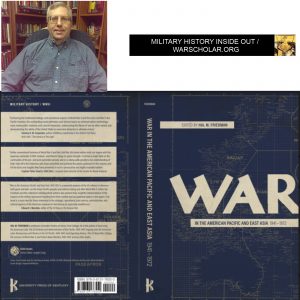Podcast: Play in new window | Download
Subscribe: RSS

Dr. Hal M. Friedman is Associate Chair of History and Professor of Modern History at Henry Ford College. He has published multiple books on U.S. national security policy in the immediate postwar Pacific. He recently edited a book on the same subject and we spoke about the subject matter and the process of publishing essay collections.
0:46 Hal talks about how he got into writing on this subject and how his father had fought in WWII.
3:25 – Hal wanted to do a collection that marked the 60th anniversary of Operation Crossroads. He talks about how this collection came about.
6:16 – Hal talks about the essays in the book and the Pacific thread that binds them together.
9:25 – Hal talks about his trilogy on American national security in the Pacific basin and how those connect to this book. The U.S. dropped Japan as the main enemy and replaced it with the Soviet Union.
11:00 – Hal brings up the term American Lake for the Pacific.
15:00 – Hal talks about the goals of the US Navy before and after WWII.
21:00 – Hal talks about how the nuclear situation was addressed right after WWII.
24:20 – Hal talks about how European colonialism affected American security plans in the Pacific.
27:04 – Hal talks about how the US tried to eject all non-native foreigners, including European Catholic missionaries, from the Micronesia Islands.
30:22 – Hal discusses the economics of the American security program in the Pacific.
44:00 – Hal talks about how he put the book together.
46:19 – Hal discusses how R1 type institutions don’t respect other institutions as much as they should.
47:52 – Hal talks about the difficulties of putting together a book of history essays.
50:00 – Hal talks about the Association of the US Army authors’ day and how helpful University of Kentucky Press has been.
52:39 – Hal talks about his next project – U.S. war plans for the Pacific from 1945-1947.
53:39 – Hal can be found at the University of Kentucky Press website.
56:36 – Hal mentions that the history field is doing badly.
Links of interest
https://www.kentuckypress.com/live/title_detail.php?titleid=5527#.XY_4w397mM8
https://www.tamupress.com/search-results/?keyword=Arguing-over-the-American-Lake
For more “Military History Inside Out” please follow me on Facebook at warscholar, on twitter at Warscholar, on youtube at warscholar1945 and on Instagram @crisalvarezswarscholar
Guests: Hal Friedman
Host: Cris Alvarez
Tags: military, history, military history, conflict, war, interview, non-fiction book, crossroads, naval history, pacific war, kentucky, henry ford, micronesia, navy, marines, marshall, chiang kai-shek, okinawa, Soviet Union, Japan, communism, nuclear war, spruance, colonialism, Interior, AUSA, OPLANS
